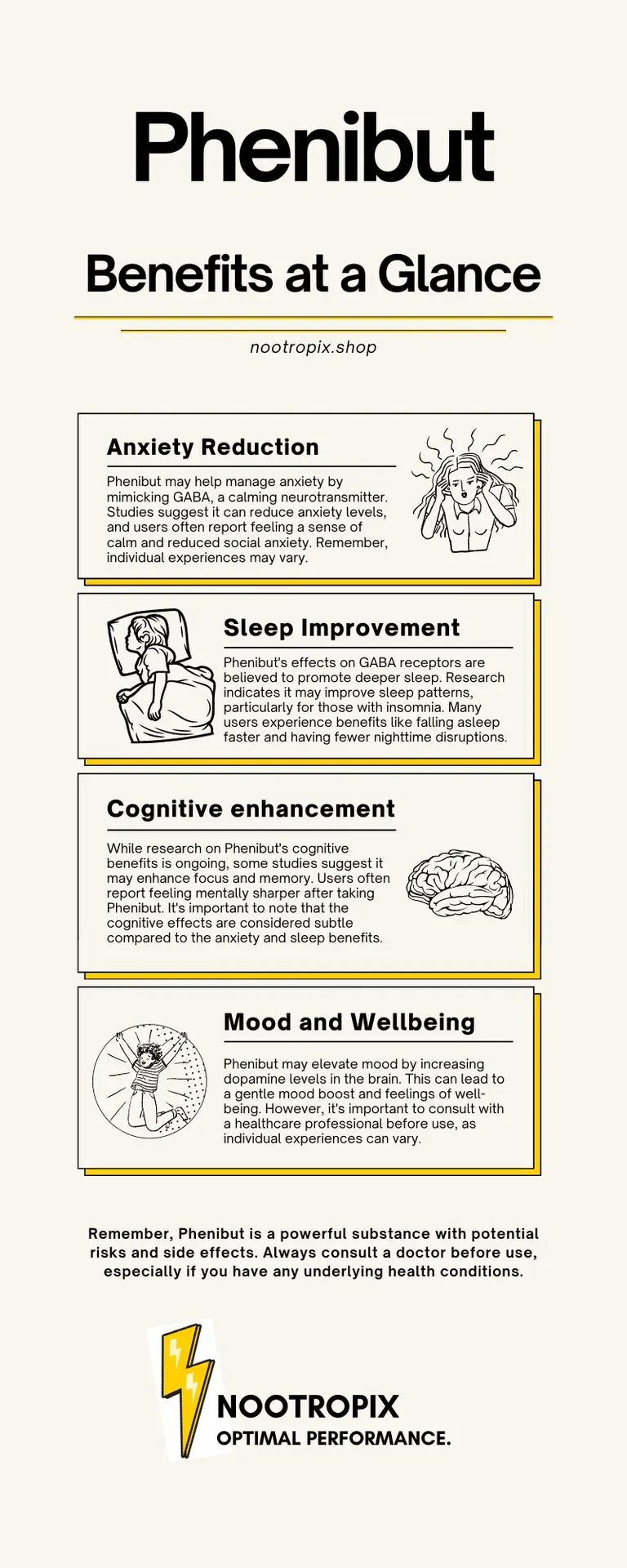Understanding Phenibut (β‑Phenyl‑GABA): Mechanism, Benefits, Risks, Dosage & Legal Status in 2025

A clear, current guide to Phenibut: how it works, potential benefits for anxiety and sleep, real risks (tolerance, dependence, withdrawal), and the 2025 legal status in the U.S., Australia, and EU—plus responsible‑use tips and Nootropix product options.
Quick take: Phenibut is a GABA‑B–acting compound that may ease anxiety and improve sleep when used sparingly, but it carries real risks of tolerance, dependence, and difficult withdrawal—so informed, cautious use matters. [Ref 1, 2]
What is Phenibut?
Phenibut (β‑phenyl‑γ‑aminobutyric acid) is a synthetic analogue of GABA developed in the former Soviet Union.
The added phenyl ring helps it cross the blood–brain barrier, where it primarily modulates inhibitory signaling and dampens nervous system over‑arousal. [Ref]
Historical context
First synthesized in the 1960s and introduced clinically in the 1970s, Phenibut was explored for stress resilience, sleep, and situational anxiety. [Ref]
Mechanism of action
- Primary action — GABA‑B agonism: Produces a calming, anxiolytic effect. [Ref 1, 2]
- Additional target — α2‑δ subunit (calcium channels): May contribute to anxiolytic/analgesic effects, similar to gabapentinoids. [Ref]
- Monoamine modulation: Animal data show changes in dopamine metabolites (e.g., elevated DOPAC in striatum), suggesting subtle mood/motivation effects. [Ref]
Takeaway: GABA‑B activity is the core. Reports of direct GABA‑A involvement are mixed; they are not considered the primary mechanism. [Ref]
Potential benefits

Anxiety reduction
Via GABA‑B agonism, Phenibut can reduce somatic tension and social unease for some users. [Ref]
Improved sleep quality
Many report easier sleep onset and deeper sleep after stressful periods; mechanistically this aligns with reduced excitability through GABA‑B signaling. [Ref]
Risks & side effects
Common effects
- Drowsiness, dizziness, nausea, headache, slowed reaction time.
Tolerance, dependence & withdrawal
Frequent/long‑term use can lead to tolerance, dependence, and a difficult withdrawal (anxiety, insomnia, agitation; severe cases can involve delirium or seizures). [Ref 1, 2]
Overdose
- High doses raise risk of profound sedation, respiratory depression, coma; seek urgent care if suspected.
Dangerous combinations
- Alcohol or other CNS depressants: Do not combine—additive respiratory/CNS depression can be life‑threatening.
Legal status (updated for 2025)
- United States (federal): Not an approved dietary ingredient; supplements listing phenibut are considered misbranded. Not scheduled federally. [Ref 1, 2]
- Alabama (USA): State‑controlled (Schedule II) since Nov 14, 2021. [Ref]
- Utah (USA): Added to Schedule I in 2025 (HB0173; signed Mar 25, 2025). [Ref]
- Australia: Schedule 9 (prohibited substance) since Feb 2018. [Ref]
- EU examples: Controlled in France, Italy, Lithuania, Hungary; other member states vary. [Ref]
Note: Laws change quickly; always confirm local regulations before purchase or use.
How to use responsibly (not medical advice)
- Limit to occasional use (e.g., 1–2 times/week) to reduce tolerance/dependence risk.
- Start low; avoid same‑day redosing.
- Never combine with alcohol, benzodiazepines, opioids, or sedatives.
- Do not drive or operate machinery after taking Phenibut.
- If discontinuing after regular use, taper under medical supervision. [Ref]
Phenibut FAQ
What’s a typical dose?
Many start around 250–500 mg; experienced users may use 500–750 mg. Higher doses increase adverse effects—more is not better.
How long do effects last?
Onset ~1–2 hours; effects can persist for many hours and occasionally into the next day.
Is Phenibut addictive?
Frequent use can be habit‑forming; withdrawal can be significant. [Ref 1, 2]
How does it compare to benzodiazepines?
Different receptors (GABA‑B vs. GABA‑A). Both can cause sedation; both are risky with other depressants. Avoid mixing.
Can I stack it?
Avoid stacking with anything sedating; do not combine with alcohol, benzos, opioids, or sleep meds.
Related nootropics (calmer, daily‑friendly options)
- L‑Theanine 200 mg capsules: Calming without drowsiness; pairs well with caffeine.
- GABA 500 mg capsules: Gentle relaxation and bedtime support for some users.
- Ashwagandha KSM‑66: Adaptogenic support for stress and sleep quality.
Shop Phenibut formats
Resources
NIH PubChem — Phenibut (compound entry): [Ref]
Medical disclaimer: This article is informational and not medical advice. Speak with a qualified clinician before using Phenibut, especially if you have health conditions or take medications.